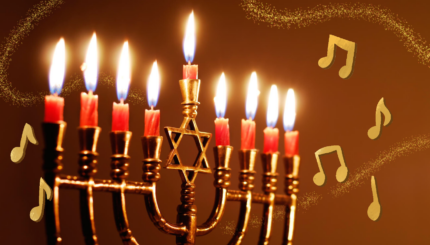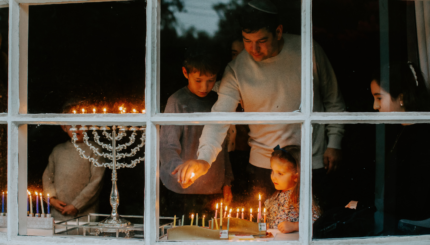Menorah Under the Sea is a different kind of picture book than you’d expect — and not just because it’s about Hanukkah. At first I couldn’t make up my mind whether to read it to my daughter or put it on my coffee table and show it off to friends. Right now, I’m doing both, and both are working out pretty well.
This gorgeous book tells a simple story: Dr. David Ginsburg is a marine biologist who traveled to McMurdo Station, the United States’ main base of operations in Antarctica, to do research on sea urchin reproduction (more below). His visit happened to overlap with Hanukkah. And, while he was there, he let some sea urchins in on the fun. Below, check out the book on Google Books (the paper version is much glossier, and much prettier, than your computer screen), and then scroll below to read our interview with Dr. Ginsburg.
(And just in case you’re keeping track: Dr. Ginsburg isn’t the only Jew ever to breech the South Pole. Last Rosh Hashanah, we spoke to Dr. Don Shuwarger, a Jewish doctor who spent the New Year in Antarctica.)
MJL: How many people live at McMurdo? I thought it’d be a small base, but it looks in the book like a whole town.
Dr. Ginsburg: The number of people at McMurdo depends on the time of year. During the winter the base is essentially cut off from visitors for 6 months. Only about 150 people remain on-station during this time. The first flights to return to McMurdo begin in late August/early September (technically, still winter) and bump the population up by 150-plus people. The next big round of flights (arriving almost daily at this point) begin in early October (known as main body), and this is when McMurdo’s population really ramps up…by December and January, more than 1000 people are on-station (scientists, support staff, military, etc.). By late February or early March, all main body people have left and the base operates on a quasi-skeleton crew for the winter. Very, very, very rarely do scientists stay at McMurdo for the winter season.
Where did you get the idea for an urchin menorah? Did you go down there and suddenly get inspired, or did you have it in mind as it was happening?
The menorah idea came to me because my dive buddy (rob) arranged an underwater photo of sea stars (with an urchin on top) in the shape of a Christmas tree. He used this picture as a holiday card. I thought this was a great idea so devised a plan (with him — since he is the underwater photographer) to create a menorah using the urchins i was collecting for my research. Once we took the photo, i Photoshopped a Hanukkah greeting onto the picture and sent it around to family and friends…this picture is in the book and was the impetus for [author] Esther [Susan Heller] to write the story in the first place
Why are sea urchins colored so brightly? Wouldn’t it attract predators?
While the urchins are brightly-colored — reds, purples, etc. — you have to remember that light is scattered with depth once it enters the ocean. The first colors “lost” are the reds, and the last to go are the blues and greens. So, while the urchins look bright to us, underwater they are drab and — for lack of a better descriptor — relatively invisible! You need a strobe light/flashlight to see what colors organisms are underwater.
What research were you doing there? What were the results?
The research i was doing is fairly complicated and difficult to explain in a brief sentence…here’s a quick and dirty overview. Essentially, my labmates and i were interested in how the babies — the embryos and larvae — of sea urchins and starfish are able to live in the extreme cold. By “live” i’m referring to how are physiological/cellular mechanisms (i.e. the synthesis of proteins, which is required by all organisms to make DNA, RNA, muscle, energy, etc.). Of these organisms altered (if at all) when they are exposed to the coldest water on earth (28 degrees Fahrenheit) and deprived of food (starved) for more than nine months out of the year. (For more details see this site.)
Is there a community of Jews at McMurdo? How do you go about seeking each other out?
There were a handful of us, maybe 4-7 at any one time (out of 1000-plus people; kind of symbolic of the global jewish population, isn’t it?). I suppose we sort of self-assembled…none of us was very religious.
However we were interested in recognizing hanukkah. I actually packed a small “travel” menorah — at the suggestion of my wife, who bought it for me — specifically for celebrating Hanukkah on the ice.
Last year, I was fortunate enough to talk to Don Shuwarger, who was a doctor at the Antarctic base during Rosh Hashanah. My more informal question is, did you guys meet up?
Never met him…was he at mcm? Pole? Palmer? There are several research bases…
And the other half is, he knew that some holiday customs, like doing tashlikh by a river, weren’t likely to happen, and so he developed his own ways of interpreting them (that specific ritual involved a recycle box). Did you encounter similar roadblocks when you were staying there?
We simply lit the candles (which technically is not allowed considering the fire dangers in the extreme cold) — so we bent the rules and lit the candles under “controlled” conditions (i.e., we blew the candles out instead of letting them burn all the way…fire is a very serious thing down there…a small fire could take the entire station down!). One day, a couple of the military chaplains even joined us.
Hanukkah
Pronounced: KHAH-nuh-kah, also ha-new-KAH, an eight-day festival commemorating the Maccabees' victory over the Greeks and subsequent rededication of the temple. Falls in the Hebrew month of Kislev, which usually corresponds with December.
menorah
Pronounced: muh-NOHR-uh, Origin: Hebrew, a lamp or candelabra, often used to refer to the Hanukkah menorah, or Hanukkiah.


